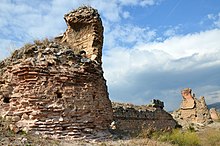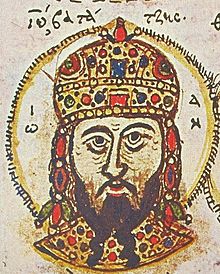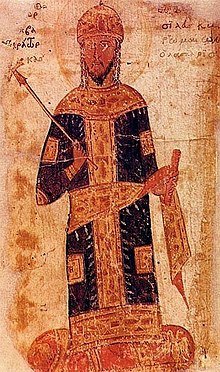User:Dkzzl/吕基亚与潘菲利亚
| 狄奥多尔二世·杜卡斯·拉斯卡里斯 Θεόδωρος Δούκας Λάσκαρις | |
|---|---|
| 罗马人的皇帝与独裁者 | |
 狄奥多尔二世的肖像(来自一份15世纪的手抄本,其内容是约翰·佐纳拉斯的《历史摘录》) | |
| 尼西亚皇帝 自称流亡在外的拜占庭皇帝 | |
| 統治 | 1254年11月3日 – 1258年8月16日 |
| 前任 | 约翰三世 |
| 繼任 | 约翰四世 |
| 出生 | 1221或1222年 尼西亚 (今土耳其布尔萨省伊兹尼克) |
| 逝世 | 1258年8月16日 马格内西亚 (今土耳其艾登省特勤) |
| 配偶 | 保加利亚的埃莱娜·阿森尼娜 |
| 子嗣 更多 | 伊琳娜·杜卡伊娜·拉斯卡里娜 优多克西阿·拉斯卡里娜 约翰四世 |
| 王朝 | 拉斯卡里斯家族(母系) 瓦塔采斯家族(父系) |
| 父親 | 约翰三世·杜卡斯·瓦塔采斯 |
| 母親 | 伊琳娜·拉斯卡里娜 |
狄奥多尔二世·杜卡斯·拉斯卡里斯(希臘語:Θεόδωρος Δούκας Λάσκαρις,羅馬化:Theodōros Doukas Laskaris;1221或1222年 -1258年8月16日)是1254-1258年间在位的尼西亚皇帝。他是皇帝约翰三世与皇后伊琳娜·拉斯卡里娜的独子,他的母亲则是在1204年第四次十字军攻陷君士坦丁堡后,在小亚细亚创立尼西亚帝国的皇帝狄奥多尔一世之长女。狄奥多尔二世从小接受两位学者尼基弗鲁斯·弗莱米泽斯与乔治·阿克罗波利特斯的精心教导,并与一些年轻知识分子建立友谊,与出身低微的乔治·穆扎隆关系最好。狄奥多尔自年轻时就开始撰写神学、历史、哲学主题的论文。
1235年,皇帝约翰三世安排他与保加利亚公主埃莱娜·阿森尼娜结婚,并与她的父亲伊凡·阿森二世结成同盟以共同对付君士坦丁堡的拉丁帝国。狄奥多尔自称婚姻幸福,这对夫妇生育了五个或六个孩子。1241年后,由于父亲经常在巴尔干半岛作战,狄奥多尔担任他在小亚细亚的副手,1242年左右,他成为父亲的共治者,但并未被加冕为共治皇帝。这段时期,他与几个大贵族,尤其是狄奥多尔·菲莱斯与米海尔·巴列奥略的关系变得紧张。
1254年11月4日,狄奥多尔继承了父亲的皇位。他贬斥了许多出身贵族的官员与将领,代以忠诚的友人,其中许多人都出身不高。他与鲁姆苏丹凯考斯二世结成同盟,共同防御蒙古帝国。他还击退了保加利亚对马其顿、色雷斯的入侵,并迫使伊庇鲁斯的米海尔二世·科穆宁·杜卡斯将都拉齐翁及亚得里亚海沿岸地区割给尼西亚。他还改革了军队,更多地自小亚细亚的原住农民中招募新兵。后来伊庇鲁斯的米海尔二世与塞尔维亚国王斯特凡·乌罗什一世、西西里国王曼弗雷迪缔结了对抗尼西亚的同盟,1257年的战斗中,狄奥多尔的新将领们无力抵抗他们的联合进攻。与此同时,狄奥多尔病重,在他生命的最后几个月内都难以参与国家事务。他可能死于癌症或慢性癫痫,临死前,他任命乔治·穆扎隆为他未成年的儿子约翰四世的摄政,但十天之后,乔治被一群贵族谋害,米海尔·巴列奥略接任摄政,最终篡位自立。
少年生活
[编辑]童年
[编辑]1221年末或1222年初,狄奥多尔在尼西亚城内的皇宫中呱呱坠地,他的父母是皇帝约翰三世·杜卡斯·瓦塔采斯与皇后伊琳娜·拉斯卡里娜[1]。伊琳娜则是尼西亚帝国的创立者狄奥多尔一世·拉斯卡里斯的长女[1]。尼西亚帝国是拜占庭帝国的继承国,创立于1204年西欧人(“拉丁人”)的第四次十字军攻陷君士坦丁堡之后[2][3]。约翰三世是伊琳娜的第三任丈夫,出身于一个与科穆宁家族、安格洛斯家族有亲戚关系的贵族家族。与伊琳娜结婚后,他成为“国库卫队长官(βεστιαρῖται,一支禁卫军的首领)”,此时伊琳娜的两个弟弟都已早逝,但狄奥多尔一世并没有正式指定约翰为他的继承人,他可能期待他的第三任妻子拉丁人库特奈的玛利亚能给他生个儿子,但最终二人没能生育[4]。1221年11月,狄奥多尔一世去世,约翰三世面临着争位者,他于1223-1224年的冬季在波伊马内农战役击败的妻子的的两个兄弟伊萨克与阿莱克修斯与他们的拉丁人盟军,开始了收复被拉丁人占领的拜占庭帝国小亚细亚领土的进程[5]。
狄奥多尔是父母的独子,他的母亲在生下他后因骑马出现意外而失去了生育能力,他采用了母亲的族姓[6]。他自称“被按养育皇室子女的惯常方式养大”,可能指的是他在皇宫的女性区域长大、为奢华围绕。他的童年十分快乐,而且父亲也“经常给他最大的安慰”,他还曾回忆起当他的教师指责他的恶行时,他的父母并没有惩罚他[7]。
教育
[编辑]
如果狄奥多尔的像其他贵族子弟一样在惯常的年龄开始学习读写,那么他就是于1228年开始接受启蒙教师的教育。作为教育的一部分,他开始背诵《圣经》中的段落并每天祈祷三次,直到生命的尽头,他都可以不看书本而直接引用《诗篇》和耶稣的各种比喻[8]。1230年,狄奥多尔开始接受第二层次的教育,他很讨厌他的“王子导师(βαΐουλος)”,在自己的作品中称他“非常爱唠叨”,但没有记下他的名字。在这一阶段,他学习语法(古典时代的阿提卡希腊语语法)、诗歌、修辞、逻辑、算术、天文、几何与音乐,总共学了三年。语法方面的学习激发了他对多义词与词源学的终身兴趣,他还着迷于德摩斯梯尼和塔尔苏斯的赫尔墨格内斯的演说,还高度推崇神学家圣额我略·纳齐安。他的导师嘲讽他过于“哲学化”,敦促他多花时间研究军事和外交。学习之余,他还热衷于打猎与“齐卡尼翁(τζυκάνιον,即马球)”,骑术十分精湛[9]。
克洛科特尼察战役后不久,狄奥多尔的父亲开始计划让他与保加利亚沙皇伊凡·阿森二世之女公主埃莱娜结婚;这场战役中,狄奥多尔未来的岳父击败并俘获了塞萨洛尼基皇帝、伊庇鲁斯统治者狄奥多尔·科穆宁·杜卡斯,削弱了伊庇鲁斯-塞萨洛尼基这一同样试图恢复拜占庭帝国的政权、尼西亚帝国在西部的竞争对手,保加利亚成为巴尔干半岛的霸主[10]。1235年,狄奥多尔与埃莱娜结婚,他们的父亲则缔结了对抗君士坦丁堡的拉丁帝国的同盟,并于同年派军共同围攻君士坦丁堡,但没能攻下。1237年,伊凡·阿森的态度发生180度转变,转而与拉丁人结盟,共同抵制尼西亚帝国在色雷斯的扩张,但同年年底又恢复了与尼西亚的联盟。岳父的这一系列举措让狄奥多尔觉得不能完全信任保加利亚——这个看法伴随了他一生[11]。
狄奥多尔后来请到了当时最有名的学者之一——时任以弗所一所修道院院长(ἡγούμενος)的尼基弗鲁斯·弗莱米泽斯担任他的老师,为他讲授哲学。狄奥多尔的哲学课在他前往父亲在尼姆菲翁(今凯末尔帕夏)附近的冬季行宫时进行。尼基弗鲁斯对亚里士多德主义充满热情,对狄奥多尔产生了很大影响,后者在自己的著作中经常提及亚里士多德提出的概念,如“潜能与现实”。13世纪40年代初,有学生指控尼基弗鲁斯侵吞公款,虽然狄奥多尔的父亲介入,使他不必遭受牢狱之灾,但他也从此放弃了教学,此后狄奥多尔仍继续定期拜访他并与他保持通信。出生于君士坦丁堡,并曾亲身经历拉丁人的统治的年轻学者乔治·阿克罗波利特斯取代了他,成为狄奥多尔的新任首席教师,并指导狄奥多尔完成了逻辑与数学教育[3][12]。
1239年后半年,狄奥多尔的母亲去世[13]。1340年夏末,他的父亲约翰三世与神圣罗马皇帝腓特烈二世年仅十岁左右的私生女康斯坦扎(婚后改名安娜)订婚。但约翰三世却爱上了未来新娘的意大利侍女马尔凯西娜(Marchesina),还给予她穿紫色(皇室的代表色)鞋子、用紫色饰物装点马具这些皇帝的近亲才有的待遇[14]。
青年
[编辑]初次承担管理任务
[编辑]
如果约翰三世遵循之前的先例,狄奥多尔会在还是个孩子的时候就被宣布为父亲的共治君主。记述发生于1235-1237年及1242年的事件时,狄奥多尔的老师乔治·阿克罗波利特斯在他的历史著作中提及了狄奥多尔的共治皇帝地位;狄奥多尔也在书信中自1242年左右之后自称皇帝。但尼基弗鲁斯·格雷戈拉斯、乔治·帕希梅莱斯这两位后代的拜占庭史家却否认他的共治皇帝地位,一种比较合理的解释是,他在父亲的有生之年内并未被加冕[15]。狄奥多尔的权力并不小,他可以授予地产与薪酬,并干涉司法纠纷,他曾应尼基弗鲁斯·弗莱米泽斯的请愿书,要求以弗所都主教将据说是非法购买的一片土地还给弗莱米泽斯的修道院。父亲在外时,他还曾主持重臣会议,并为空缺的教会职位提出了候任者[16]。
1241年5月,约翰三世再次尝试围攻君士坦丁堡,但很快意识到他还无法将其收复,于是他开启了和平谈判,并让狄奥多尔随他会见拉丁人的使者。6月24日,双方签订了为期两年的和约;同月,保加利亚的伊凡·阿森二世去世,削弱了保加利亚的力量。1241年末,约翰三世又对保加利亚的盟友伊庇鲁斯发起进攻,率军出发前,他命狄奥多尔代他管理小亚细亚事务。狄奥多尔遵循外祖父和父亲的做法,带着宫廷人员巡回各地,访问了安纳托利亚的许多城镇与村庄[17]。
这时,蒙古将领拜住率军自东面侵攻尼西亚的邻国罗姆苏丹国,攻占了埃尔祖鲁姆。狄奥多尔通知了他正在围攻塞萨洛尼基的父亲,但约翰三世选择不放弃进攻,他的坚持得到了回报,塞萨洛尼基的统治者约翰·科穆宁·杜卡斯放弃了自称的皇帝头衔,接受了约翰三世赐予的“专制君主”衔。1243年,蒙古人再次进攻罗姆苏丹国,并于6月26日在克塞山战役中击溃了苏丹凯霍斯鲁二世的军队。此后,塞尔柱人被迫向蒙古人缴纳年贡,尼西亚帝国成为整个安纳托利亚唯一一个保持完全独立的国家,但对蒙古人入侵的恐惧也成为影响尼西亚外交政策的一大因素[18][19]。
1246年,约翰三世再次率军进攻色雷斯,继续将小亚细亚留给狄奥多尔管理。这次远征中,约翰三世先是夺取了塞雷,之后塞萨洛尼基的上层市民不愿承受又一场长期的围城战,于是打开了城市的大门,自愿向他投降,之后多数马其顿城镇纷纷效仿,尼西亚的领土几乎扩大了一倍[20][21]。
伙伴
[编辑]狄奥多尔与一群年轻的知识分子建立了亲密的友谊,他们都出生于拉丁人攻陷君士坦丁堡之后,不像他们的父辈,所谓“被羞辱的一代(普世牧首日耳曼努斯二世语)”经历了被迫流亡的惊愕。他的朋友们的陪伴帮助他度过了一段可能由焦虑于承担政治责任而引起的忧郁时期。他最亲近的朋友是他的童年玩伴乔治·穆扎隆,根据尼基弗鲁斯·弗莱米泽斯的说法,穆扎隆三兄弟——乔治与他的兄弟狄奥多尔、安德洛尼卡都“出身低微”,但他们都有歌唱与音乐的天赋。狄奥多尔的其他密友的出身则多与高阶世俗及教会官员有关,如约瑟夫·美索不达米特斯(Joseph Mesopotamites)、孔斯塔斯·阿吉欧塞欧多里特斯(Konstas Hagiotheodorites)[22]。
狄奥多尔经常取笑主教们的自我夸大、蛮族般的语言风格以及因无知造成的异端言论,甚至嘲笑他们的外表。但也有很多人对他发表了嘲讽言论,他的同学们在哲学讨论中取笑他的辩论风格,但贵族与教士们的批评则更加危险:以弗所的都主教尼基弗鲁斯谴责他犯了骄傲的罪,还不遵从禁食的规定;一位将领卡洛塞托斯(Kalothetos)对他发表了不敬的评论;他与塞萨洛尼基的总督狄奥多尔·菲莱斯关系十分紧张,后者散发了宣称狄奥多尔与某位女子有染的谤诗,狄奥多尔则指责他为杀害友人特里比德斯(Tribides)的幕后黑手(不过特里比德斯的死也表明,狄奥多尔在他父亲在世时就已能将自己的亲信派到新征服的欧洲领土)。菲莱斯的指责也传到了狄奥多尔的老师尼基弗鲁斯·弗莱米泽斯的耳朵里,他显然不会容忍性方面的越轨。1248年左右,弗莱米泽斯拒绝让约翰三世的情妇马尔凯西娜(Marchesina)及其随从进入他在以弗所的修道院,他还为狄奥多尔及他的父亲写了一本指导君王的书,题名《论王道》(Βασιλικὸς ἀνδριάς),告诫他们不要好色、浪费公共资金。狄奥多尔无法说服老师这是一场诬陷[23]。
走向单独统治
[编辑]约翰三世准备再次攻击君士坦丁堡,但伊庇鲁斯的统治者米海尔二世·科穆宁·杜卡斯于1252年春季进犯尼西亚在马其顿的领土,约翰三世再次亲自率军远征,将小亚细亚托付给狄奥多尔,最终迫使米海尔撤回伊庇鲁斯。但在此期间,狄奥多尔的妻子埃莱娜于8月末突然去世,狄奥多尔为妻子服丧的时间超过了惯例的四十天,只是在父亲的命令下,他才停止禁食、不再穿黑衣。妻子的死加剧了他的忧郁,他隐居在宫中,致力于哲学研究与写作,直到1253年才恢复对小亚细亚城镇的定期访问[24][25]。
1253年初,神圣罗马皇帝腓特烈二世的儿子与继承人康拉德迫使父亲的情妇比安卡·蓝齐亚的亲属们流亡,他们来到尼西亚,向比安卡的女儿,尼西亚皇后安娜(原名康斯坦扎)寻求庇护。但当时约翰三世在色雷斯,狄奥多尔接待了这批人。之后康拉德又回心转意,派蓝齐亚家族的姻亲、博学的霍恩堡的贝特霍尔德(Berthold of Hohenburg)到尼西亚与他们协商。等待父亲自色雷斯归来时,狄奥多尔与贝特霍尔德进行了哲学讨论,此时西欧对于研究古希腊哲学也越来越有兴趣,贝特霍尔德还向狄奥多尔索要古希腊哲学书籍。这一请求也加强了狄奥多尔对古希腊遗产的自豪感,他还决定出版自己的作品[26]。
1253年冬天,约翰三世回到了尼西亚,1254年初,他突然病倒,此后一直没有康复。他的疾病使狄奥多尔成为帝国的实际统治者,但这并没有让他改变出版自己作品的计划。蒙古人将再次入侵小亚细亚的消息传来时,他的父亲还活着[27]。
统治
[编辑]登位
[编辑]1254年11月4日,约翰三世在尼西亚去世,留给狄奥多尔一个强盛的帝国[3]。狄奥多尔被承认为皇帝,但由于普世牧首之位暂时空缺,没有立即加冕。狄奥多尔的老师乔治·阿克罗波利特斯在约翰三世的葬礼上致辞,表示希望狄奥多尔能带领尼西亚帝国驱逐君士坦丁堡的拉丁人,将他比作《出埃及记》中引导以色列人的“火柱”[28]。 但狄奥多尔实际并没有冒险进攻君士坦丁堡,因为他的帝国为敌对势力所环绕[29]。
狄奥多尔禁止他父亲的遗孀安娜-康斯坦扎返回故乡西西里,这激怒了她的兄弟,刚刚成为西西里王国实际统治者的曼弗雷迪[30]。狄奥多尔与罗姆苏丹凯考斯二世在非拉铁非会面,达成了防御蒙古人的同盟。凯考斯虽然承认蒙古人的宗主权,但他拒绝前往蒙哥汗的宫廷向他表示臣服[31][32]。
狄奥多尔想任命他的老师弗莱米泽斯为新任牧首,但被他拒绝了;之后他提名一位出身贵族的隐修士阿尔塞尼欧斯·奥托雷阿诺斯,后者接受,于是在1254年圣诞节(根据学术界的共识),新任牧首膏立新帝并为其加冕。围绕这位牧首的废立问题,教会内部还于1265-1310间爆发了内部争执,即所谓“阿尔塞派分裂”[33]。这位牧首一直是狄奥多尔的忠实支持者,并服从他的指令[34]。
狄奥多尔不信任贵族,1254年12月写给乔治·穆扎隆的信中,他写到“禁忌的桃色事件与非常不公正的阴谋”,但没有说明是谁在反对他。学者迈克尔·安戈尔德提出,神圣罗马皇帝腓特烈二世实行的类似政策可能启发狄奥多尔“对他手下的贵族采取更为专制的态度”[35]。狄奥多尔任命乔治·穆扎隆为“大统帅(μέγας δομέστικος)”,即野战军总司令,并任命乔治的兄弟安德洛尼卡为“首要国库卫队长官(πρωτοβεστιαρίτης)”,即皇宫卫队长官。他还起用了其他出身一般的将领,如君士坦丁·马尔加里特斯,还重新任用那些在他父亲时被忽视的贵族,如他召回了被流放的他外祖父老皇帝狄奥多尔一世的兄弟米海尔、曼努埃尔,并让曾叛乱的内斯同戈斯(Nestongos)家族的两个成员:乔治与伊萨克成为将领。这一系列任命冒犯了大多数贵族[36]。
与保加利亚的战争
[编辑]
约翰三世死后,年轻的保加利亚沙皇米海尔二世·阿森想趁机收复1241年前保加利亚一度占有的领土,1254年12月或1255年1月,米海尔率军入侵马其顿与色雷斯[6][30][37]。尼西亚帝国在当地各要地的驻军普遍不多,当地的保加利亚人平民也支持敌军[37][38]。保加利亚军迅速夺取了色雷斯的多数堡垒,两座马其顿城市韦莱斯与斯科普里也宣布投降。仓促召集的军事会议决定采用乔治·穆扎隆提出的立即反击的战略,狄奥多尔决定亲自统帅军队,并于1255年2月命穆扎隆暂时管理小亚细亚事务。敌人没有预料到他的反击,撤出色雷斯,于是他命将领阿莱克修斯·斯特拉特戈普罗斯、季米特里俄斯·托尔尼克斯(Demetrios Tornikes)追击保加利亚军队。这两位将领率军穿越了罗多彼山脉的隘口,但一直害怕被伏击,某次偶然听到牧羊人、牧猪人吹起号角,他们就陷入了恐慌,抛下了全部辎重。狄奥多尔为此感到震怒,命令他们迅速回到他在阿德里安堡的大本营,但二人都不从命[39][40]。
一名为尼西亚帝国效力的保加利亚叛徒德拉戈塔斯(Dragotas)于夏天再次转换阵营,于夏季开始围攻梅尔尼克。狄奥多尔闻讯匆忙离开阿德里安堡,带兵前往援救,保加利亚军在鲁佩尔山口为他设下埋伏,但狄奥多尔没有上当,就在他到达梅尔尼克之前,德拉戈塔斯放弃了包围。之后狄奥多尔前往塞萨洛尼基,罢免了当地的总督,与他有旧仇的狄奥多尔·菲莱斯,他还关闭了当地的铸币厂,因为他希望将铸币权统一收归小亚细亚的中央政府,并在赫勒斯滂海峡亚洲一侧的阿斯特里齐翁(Astritzion)建立新的国库。随后狄奥多尔攻入马其顿,迫使韦莱斯的保加利亚驻军投降,但旱灾使他无法继续在本就干旱的奥维切平原作战,于是他前往塞雷,在那里确认了马其顿诸城镇的财政特权,他还下令逮捕奥赫里德都主教君士坦丁·卡瓦斯拉斯,因为他认为后者是伊庇鲁斯的米海尔二世的忠实支持者[41]。
1255年晚秋,蒙古人入侵小亚细亚的传言迫使狄奥多尔离开马其顿,但很快传言被证明为假,于是他转而准备进攻保加利亚的采皮纳要塞,但他的军队无法翻越狭窄而寒冷的山地隘口,于是他放弃作战,于年底回到了安纳托利亚。他为他的知己们带来了荣誉与礼物:任命君士坦丁·马尔加里特斯、曼努埃尔·拉斯卡里斯指挥色雷斯军队,并责成乔治·穆扎隆进行军事改革。他还下令惩罚几位古老贵族家庭的成员::君士坦丁·斯特拉特戈普罗斯、狄奥多尔·菲莱斯被瞽目;阿莱克修斯·斯特拉特戈普罗斯与阿莱克修斯·拉乌尔的四个儿子被囚禁;狄奥多尔的远房表弟米海尔·巴列奥略则因害怕被囚禁而逃到塞尔柱人处。狄奥多尔还运用皇帝控制贵族婚姻的权力,迫使贵族家族与他出身低微的宠臣联姻,乔治·穆扎隆迎娶了米海尔·巴列奥略的侄女狄奥多拉·拉乌尔莱娜,安德洛尼卡·穆扎隆则与阿莱克修斯·拉乌尔的女儿结婚[42]。
1256年4月或5月,狄奥多尔决定恢复与罗马的教会联合谈判,并遣使教皇亚历山大四世。一直以来,对“和子说”的不同看法是正教会与天主教会分裂的重要原因。正教会神学坚持认为“圣灵由父而出”,而天主教会认为“圣灵由父和子而出”。Theodore commissioned Blemmydes to summarize the Orthodox position. Blemmydes adopted a conciliatory approach, concluding that a statement about the procession of the Holy Spirit from the Father through the Son was fully in conformity with the Bible and the Church Fathers' works. Theodore did not accept his tutor's view and insisted on the traditional Orthodox doctrine.[43]
Michael II of Bulgaria dispatched Cuman raiders to plunder Thrace early in 1256. Although Theodore had instructed Laskaris and Margarites to adopt a defensive strategy, they pursued the Cumans, but the invaders inflicted a heavy defeat on their troops. Theodore assembled a new army, partially mustered among the Anatolian peasantry, and crossed the Hellespont. He sent troops, including Cuman horsemen in his service, against the invaders and they routed the enemy forces in two battles in Thrace.[44] He entered into peace negotiations with Michael II with the mediation of Rostislav Mikhailovich, Duke of Macsó. Michael II had recently married Rostislav's daughter and Rostislav's wife, Anna of Hungary, was Theodore's cousin. Rostislav came to Thrace to reach an agreement with Theodore. Akropolites drafted a treaty about the restoration of the prewar boundaries between Nicaea and Bulgaria. Rostislav accepted it and signed the peace treaty on Michael II's behalf on 29 June. The treaty prescribed that Michael II cede Tzepaina to the Nicaeans, but the Bulgarian garrison was not withdrawn immediately from the fortress. Theodore became convinced that Rostislav had deceived him and ordered the public whipping of Akropolites. His act proved imprudent, because the Bulgarians ceded the fortress in early September. Theodore sent George Mouzalon to Akropolites to seek a reconciliation.[37][45][46]
The peace treaty aroused much indignation in Bulgaria, enabling Michael II's cousin, Kaliman, to stage a plot and dethrone the Tzar. Kaliman seized the throne, but he never gained the support of the army. After he fell victim to a new plot, Rostislav Mikhailovich and Michael II's brother-in-law, Mitso, laid claim to the throne. Most boyars (noblemen) preferred a third candidate, one of their number, Konstantin Tih, although he was not related to the ruling Asen dynasty.[47][48][49]
扩张
[编辑]Theodore's war against Bulgaria brought about a rapprochement between Epirus and Serbia. Michael II of Epirus made a formal alliance with Stefan Uroš I, King of Serbia. He also sent gifts to the Albanian chiefs who had acknowledged Nicaean suzerainty to gain their support. Theodore's daughter, Maria, and Michael II's son and heir, Nikephoros, had been engaged during Vatatzes' reign. After making peace with the Bulgarians, Theodore ordered Michael II to send Nikephoros to Thessalonica to wed Maria. Nikephoros was accompanied by his mother, Theodora Petraliphaina. Theodore took her into custody, only allowing her to return to Epirus after Michael II ceded Servia and Dyrrachium to him. The possession of the two towns secured the Nicaean control of the Via Egnatia, but Michael II remained hostile to Theodore.[6][50]
Theodore received the papal legate, Bishop Constantine of Orvieto, in Thessalonica. Their negotiations proved fruitless, because the legate's authorization was limited and Theodore was unwilling to make concessions for the church union. He also preserved the right to convoke the Orthodox bishops to a synod to discuss the conditions of the union. Theodore maintained a correspondence with the Holy See, but he did not initiate new negotiations with it.[51]
The Mongols invaded Asia Minor and defeated Kaykaus II on 14 October 1256. Theodore hurried back to Anatolia to oversee the preparations for the defense. Kaykaus sought asylum in Nicaea and the Mongols installed his brother, Kilij Arslan IV, as the new sultan of Rum. Theodore assembled his troops on the plains near Magnesia. The Mongol ruler of Persia, the Ilkhan Hülagü, sent a delegation to Theodore to begin negotiations about Kaykaus' future. Hülegü agreed to withdraw his army from Rum and ordered the division of the sultanate between Kaykaus and Kilij Arslan in the spring of 1257. Before leaving for Rum, Kaykaus ceded four fortresses in the valley of the river Lycus to Nicaea in return for a contingent of 300 auxiliary troops.[52][53] His achievements made Theodore self-confident. He proudly stated that his empire included territories as far as Dyrrachium on the Adriatic Sea and Cape Karambis on the Black Sea. His success during the war against Bulgaria had convinced him he should recruit soldiers from among Anatolian peasants. In a letter to Blemmydes, he stated that the native "Hellenes" were more reliable than foreign mercenaries.[54][55]
疾病与死亡
[编辑]
1257年11月,狄奥多尔病重。当时年仅十六岁的史家乔治·帕希梅莱斯称他患的是癫痫,并记载他经常失去知觉,倒在地上;他还认为狄奥多尔不寻常的用人政策与促使贵庶家族联姻结盟的举措是由他的疾病引起的;乔治·阿克罗波利特斯只是记载狄奥多尔的体重极度降低,身体看起来像一具骷髅;尼基弗鲁斯·弗莱米泽斯则称狄奥多尔的疾病为“一种天灾,一种奇怪的疾病”,还提到了狄奥多尔的忧郁症与恐惧症。狄奥多尔在自己的作品中也写到他的手臂曾有难以忍受的疼痛与麻痹。现代疾病学者对他的病没有一致的意见,约翰·拉斯卡拉托斯(John Lascaratos)与帕纳格希欧提斯·V·齐斯(Panaghiotis V. Zis)认为帕希梅莱斯提到的癫痫是正确的,认为狄奥多尔在快三十岁时发展出了强直-阵挛性发作癫痫[56]。学者唐纳德·尼科尔认为狄奥多尔的疾病“使他成为自己情绪的牺牲品,为了缓解焦虑,他变得专断而固执”[34]。但医学史家吉奥尔吉奥斯·马克里斯(Georgios Makris)在其1995年发表的拜占庭帝国癫痫研究中认为狄奥多尔得的并不是癫痫。学者迪米特尔·安格洛夫(Dimiter Angelov)也不认可帕希梅莱斯的说法,认为狄奥多尔最可能是得了脑癌、脊柱肿瘤或肺癌[57]。
生病使得狄奥多尔无法亲自统帅军队,而他的大多出身低微、由他提拔的将领们无力阻止伊庇鲁斯、阿尔巴尼亚人、塞尔维亚人劫掠马其顿的尼西亚领地。 Stefan Uroš I defeated the Nicaean troops near Prilep. Michael II's sister-in-law, Maria Petraliphaina, entered into a correspondence with Theodore's commander, Constantine Chabaron, making him believe that she was eager to marry him, but Chabaron was captured during their meeting. Theodore's newly assembled army of Anatolian peasants was routed at Edessa. Michael Palaiologos, who had been allowed to return from his exile, lead a new army to Macedonia. He defeated the Epirotes, but Theodore ordered him to return instead of marching to Prilep. Palaiologos' withdrawal enabled Michael II to seize Prilep and capture Akropolites, who was its governor. Michael II was planning to launch an attack against Thessalonica, but Manfred of Sicily renewed his predecessors' claim to Byzantine territories and invaded Epirus from the west. Michael II, who did not want to abandon his plan, concluded an alliance with Manfred who expelled the Nicaean garrisons from Dyrrachium and other fortresses on the Adriatic by the end of February 1258.[30][58][59]
Konstantin Tih of Bulgaria repudiated his first wife and sued for the hand of Theodore's eldest daughter, Irene. He knew that his marriage to Irene, who was Tzar Ivan Asen II's granddaughter, could strengthen his claim to rule. Theodore wanted to confirm his peace treaty with Bulgaria and accepted Konstantin Tih's offer. Irene went to Bulgaria to marry Konstantin Tih.[60][61]
Theodore rarely left his palace at Magnesia during the last months of his life. He was convinced that sorcery caused his illness and accused his courtiers of casting spells on him, sending many of them for trial. Michael Palaiologos's sister, Maria-Martha, was the most famous victim of Theodore's paranoia. Theodore had forced her daughter, Theodora, to marry the elderly Basil Kaballarios, but the marriage was never consummated. After Kaballarios had attributed his impotence to his mother-in-law's spells, Theodore had her put into a sack filled with cats that tore her flesh. She was only released because Theodore suddenly panicked, fearing her spells. Also fearing her brother's revenge, Theodore had Michael Palaiologos imprisoned on charges of poisoning, but soon set him free.[45] Theodore named his seven-year-old son, John, as his sole heir, appointing George Mouzalon regent until John came of age. He became a monk, but he kept his baptismal name. He summarized his sins in a treatise and asked the patriarchal synod to grant him absolution. He died in the imperial palace at Magnesia on 16 August 1258.[62] He was buried next to his father in the Sosandra monastery on Mount Sipylus. His grave and the monastery were destroyed after the Turkish conquest of the region in the 14th century.[63]
The aristocrats had taken an oath of loyalty to Mouzalon at Theodore's deathbed, but they soon began conspiring against him. In ten days, Mouzalon was murdered, and Michael Palaiologos assumed the regency for the child-emperor, John IV Laskaris. Palaiologos convinced the aristocrats that an empire ruled by a boy could not resist enemy attacks, and he was proclaimed co-emperor as Michael VIII before the end of the year. When Michael VIII and John IV were crowned together early in 1259, the Patriarch put the crown first on Michael VIII's head. After concluding an agreement with Genoa against the Latin Empire, he dispatched Alexios Strategopoulos to spy on the defences of Constantinople. Taking advantage of the absence of the bulk of the Latin army, Strategopoulos seized Constantinople by a surprise attack on 25 July 1261. Michael VIII was crowned for the second time, alone, in the Hagia Sophia.[59][47][64] The child John IV was blinded on 25 December 1261, which prevented him from ruling.[65] In order to emphasize that the Laskaris family had lost their imperial status, Michael VIII married off his three sisters to minor Italian and Bulgarian noblemen.[66]
学术成就
[编辑]A man of letters devoted to philosophical and theological studies, Theodore transformed his court into a center for renowned scholars shortly after his ascension to the throne.[3] He ordered that books that he and his father had collected in urban libraries be available to all who wanted to read them.[34][67] He began to write treatises on philosophical, theological and historical subjects already during his father's lifetime, but he decided to prepare manuscript editions of his works only after his meeting with Berthold of Hohenburg in 1253. His works were collected in four codices, but only three survived.[68]
Theodore's Satire of the Tutor, written most likely in 1240, is his earliest extant work. The satire is dedicated to his principal tutor, portraying him as an under-educated and rude man, who learned magic while staying in Bulgaria. He also wrote encomia in praise of the citizens of Nicaea, his father and Akropolites. Theodore's theological works—including his First Oration against the Latins, or, on the Procession of the Holy Spirit, and his treatise On the Trinity—demonstrate his adherence to Orthodox theology.[69] Theodore's Great Supplicatory Canon to Our Lady, a hymn to the Virgin Mary, is his best known work. He composed it just months before his death and it is still sung in Orthodox ceremonies.[70]
家庭
[编辑]狄奥多尔与埃琳娜在结婚时都没有达到法定的最低结婚年龄——男性十四岁、女性十二岁,但这样的早婚在尼西亚的贵族与平民中并不罕见。他的妻子1224年出生,父母是保加利亚沙皇伊凡·阿森二世与匈牙利的玛利亚。两人的结婚典礼于1235年初在兰普萨库斯举行。两年后,伊凡·阿森二世准备进攻尼西亚在色雷斯的领地,于是强迫埃琳娜返回保加利亚,但同年末两国恢复和平后,她又回到狄奥多尔身边。 Years later, Theodore described Elena as the flower of his youth and stated that their "bond of incomparable love" made them "happier than all people". Her sudden death in the spring or summer of 1252 plunged Theodore into grief. She gave birth to four or five daughters, and one son.[71] Their children were:
- 伊琳娜,与保加利亚贵族、沙皇君士坦丁·提赫(1257-1277年在位)结婚,弟弟被篡位后成为米海尔八世的死敌,直到她于约1270年去世[72]。
- 玛利亚,与伊庇鲁斯统治者尼基弗鲁斯一世结婚,死于1257-1265年之间[73][74]。
- 狄奥多拉, was married off by Michael VIII to a Moreot nobleman, Maïos Débélikourtos, according to Pachymeres and Nicephorus Gregoras. Historian Albert Failler identifies him as Matthew of Mons who held the Barony of Veligosti in the Principality of Achaea.[75]
- 优多克西阿 first married Count William-Peter of Ventimiglia, who died around 1280. Her second husband, Roger Arnau, Count of Pallars, died in 1288. The widowed Eudoxia had a love affair with the Aragonese admiral Bernat de Serria. She died in 1309.[76]
- 一个姓名未知的女儿,A Bulgarian boyar, Despot Jacob Svetoslav, married Theodore's unnamed daughter, according to Pachymeres. She may have been Theodore's illegitimate daughter, because other Byzantine historians failed to mention her.[77]
- 独子[[约翰], survived his mutilation, but he spent the rest of his life in prison. He died around 1309.[78]
| 狄奥多尔的家系及他与其他拜占庭大族的亲戚关系示意图 | |||||||||||||||||||||||||||||||||||||||||||||||||||||||||||||||||||||||||||||||||||||||||||||||||||||||||||||||||||||||||||||||||||||||||||||||||||||||||||||||||||||||||||||||||||||||||||||||||||||||||||||||||||||||||||||||||||||||||||||||||||||||||||||||||||||||||||||||||||||||||||||||||||||||||||||||||||||||||||||||||||||||||||||||||||||||||||||||||||||||||||||||||||||||||||||||||||||||||||||||||||||||||||||||||||||||||||||||||||||||||||||||||||||||||||||||||||||||||||||||||||||||||||||||||||||||||||||||||||||||||||||||||||||||||||||||||||||||||||||||||||||||||||||||||||||||||||||||||||||||||||||||||||||||||||||||||||||||||||||||||||||||||||||||||||||||||||||||||||||||||||||||||||||||||||||||||||||||||||||||||||||||||||||||||||||||||||||||||||||||||||||||||||||||||||||||||||||||||||||||||||||||||||||||||||||||||||||||||||||||||||||||||||||||||||||||||||||||||||||||||||||||||||||||||||||||||||||||||||||||||||||||||||||||||||||||||||||||||||||||||||||||||||||||||||||||||||||||||||||||
|---|---|---|---|---|---|---|---|---|---|---|---|---|---|---|---|---|---|---|---|---|---|---|---|---|---|---|---|---|---|---|---|---|---|---|---|---|---|---|---|---|---|---|---|---|---|---|---|---|---|---|---|---|---|---|---|---|---|---|---|---|---|---|---|---|---|---|---|---|---|---|---|---|---|---|---|---|---|---|---|---|---|---|---|---|---|---|---|---|---|---|---|---|---|---|---|---|---|---|---|---|---|---|---|---|---|---|---|---|---|---|---|---|---|---|---|---|---|---|---|---|---|---|---|---|---|---|---|---|---|---|---|---|---|---|---|---|---|---|---|---|---|---|---|---|---|---|---|---|---|---|---|---|---|---|---|---|---|---|---|---|---|---|---|---|---|---|---|---|---|---|---|---|---|---|---|---|---|---|---|---|---|---|---|---|---|---|---|---|---|---|---|---|---|---|---|---|---|---|---|---|---|---|---|---|---|---|---|---|---|---|---|---|---|---|---|---|---|---|---|---|---|---|---|---|---|---|---|---|---|---|---|---|---|---|---|---|---|---|---|---|---|---|---|---|---|---|---|---|---|---|---|---|---|---|---|---|---|---|---|---|---|---|---|---|---|---|---|---|---|---|---|---|---|---|---|---|---|---|---|---|---|---|---|---|---|---|---|---|---|---|---|---|---|---|---|---|---|---|---|---|---|---|---|---|---|---|---|---|---|---|---|---|---|---|---|---|---|---|---|---|---|---|---|---|---|---|---|---|---|---|---|---|---|---|---|---|---|---|---|---|---|---|---|---|---|---|---|---|---|---|---|---|---|---|---|---|---|---|---|---|---|---|---|---|---|---|---|---|---|---|---|---|---|---|---|---|---|---|---|---|---|---|---|---|---|---|---|---|---|---|---|---|---|---|---|---|---|---|---|---|---|---|---|---|---|---|---|---|---|---|---|---|---|---|---|---|---|---|---|---|---|---|---|---|---|---|---|---|---|---|---|---|---|---|---|---|---|---|---|---|---|---|---|---|---|---|---|---|---|---|---|---|---|---|---|---|---|---|---|---|---|---|---|---|---|---|---|---|---|---|---|---|---|---|---|---|---|---|---|---|---|---|---|---|---|---|---|---|---|---|---|---|---|---|---|---|---|---|---|---|---|---|---|---|---|---|---|---|---|---|---|---|---|---|---|---|---|---|---|---|---|---|---|---|---|---|---|---|---|---|---|---|---|---|---|---|---|---|---|---|---|---|---|---|---|---|---|---|---|---|---|---|---|---|---|---|---|---|---|---|---|---|---|---|---|---|---|---|---|---|---|---|---|---|---|---|---|---|---|---|---|---|---|---|---|---|---|---|---|---|---|---|---|---|---|---|---|---|---|---|---|---|---|---|---|---|---|---|---|---|---|---|---|---|---|---|---|---|---|---|---|---|---|---|---|---|---|---|---|---|---|---|---|---|---|---|---|---|---|---|---|---|---|---|---|---|---|---|---|---|---|---|---|---|---|---|---|---|---|---|---|---|---|---|---|---|---|---|---|---|---|---|---|---|---|---|---|---|---|---|---|---|---|---|---|---|---|---|---|---|---|---|---|---|---|---|---|---|---|---|---|---|---|---|---|---|---|---|---|---|---|---|---|---|---|---|---|---|---|---|---|---|---|---|---|---|---|---|---|---|---|---|---|---|---|---|---|---|---|---|---|---|---|---|---|---|---|---|---|---|---|---|---|---|---|---|---|---|---|---|---|---|---|---|---|---|---|---|---|---|---|---|---|---|---|---|---|---|---|---|---|---|---|---|---|---|---|---|---|---|---|---|---|---|---|---|---|---|---|---|---|---|---|---|---|---|---|---|---|---|---|---|---|---|---|---|---|---|---|---|---|---|---|---|---|---|---|---|---|---|---|---|---|---|---|---|---|---|---|---|---|---|---|---|---|---|---|---|---|---|---|---|---|---|---|---|---|---|---|---|---|---|---|---|---|---|---|---|---|---|---|---|---|---|---|---|---|---|---|---|---|---|---|---|---|---|---|---|---|---|---|---|---|---|---|---|---|---|---|---|---|---|---|---|---|---|---|---|---|---|---|---|---|---|---|---|---|---|---|---|---|---|---|---|---|---|---|---|---|---|---|---|---|---|---|---|---|---|---|---|---|---|---|---|---|---|---|---|---|---|---|---|---|---|---|---|---|---|---|---|---|---|---|---|---|---|---|---|---|---|---|---|---|---|---|---|---|---|---|---|---|---|---|---|---|---|---|---|---|---|---|---|---|---|---|---|---|---|---|
| |||||||||||||||||||||||||||||||||||||||||||||||||||||||||||||||||||||||||||||||||||||||||||||||||||||||||||||||||||||||||||||||||||||||||||||||||||||||||||||||||||||||||||||||||||||||||||||||||||||||||||||||||||||||||||||||||||||||||||||||||||||||||||||||||||||||||||||||||||||||||||||||||||||||||||||||||||||||||||||||||||||||||||||||||||||||||||||||||||||||||||||||||||||||||||||||||||||||||||||||||||||||||||||||||||||||||||||||||||||||||||||||||||||||||||||||||||||||||||||||||||||||||||||||||||||||||||||||||||||||||||||||||||||||||||||||||||||||||||||||||||||||||||||||||||||||||||||||||||||||||||||||||||||||||||||||||||||||||||||||||||||||||||||||||||||||||||||||||||||||||||||||||||||||||||||||||||||||||||||||||||||||||||||||||||||||||||||||||||||||||||||||||||||||||||||||||||||||||||||||||||||||||||||||||||||||||||||||||||||||||||||||||||||||||||||||||||||||||||||||||||||||||||||||||||||||||||||||||||||||||||||||||||||||||||||||||||||||||||||||||||||||||||||||||||||||||||||||||||||||
引用
[编辑]- ^ 1.0 1.1 Angelov 2019,第57頁.
- ^ Nicol 1993,第10–11頁.
- ^ 3.0 3.1 3.2 3.3 Lascaratos & Zis 1998,第296頁.
- ^ Angelov 2019,第32–34頁.
- ^ Angelov 2019,第57–59頁.
- ^ 6.0 6.1 6.2 Treadgold 1997,第721頁.
- ^ Angelov 2019,第59–60, 257 (notes 21–22)頁.
- ^ Angelov 2019,第64–66頁.
- ^ Angelov 2019,第68–72, 75–77頁.
- ^ Angold 2017,第738頁.
- ^ Angelov 2019,第65, 73–75頁.
- ^ Angelov 2019,第79, 85, 117–118頁.
- ^ Angelov 2019,第88頁.
- ^ Angelov 2019,第90–91頁.
- ^ Angelov 2019,第61, 258 (notes 34 and 36)頁.
- ^ Angelov 2019,第98–101頁.
- ^ Angelov 2019,第92, 100頁.
- ^ Korobeinikov 2017,第720–721頁.
- ^ Angelov 2019,第92–96頁.
- ^ Fine 1994,第156–157頁.
- ^ Angelov 2019,第92, 96–97頁.
- ^ Angelov 2019,第109–118頁.
- ^ Angelov 2019,第90, 118–125頁.
- ^ Angelov 2019,第92, 128–132頁.
- ^ Fine 1994,第158頁.
- ^ Angelov 2019,第140–145頁.
- ^ Angelov 2019,第147–148頁.
- ^ Angelov 2019,第148頁.
- ^ Treadgold 1997,第730頁.
- ^ 30.0 30.1 30.2 Nicol 1993,第28頁.
- ^ Korobeinikov 2017,第721頁.
- ^ Angelov 2019,第149–150頁.
- ^ Angelov 2019,第150, 296 (note 25)頁.
- ^ 34.0 34.1 34.2 Nicol 1993,第27頁.
- ^ Angold 2017,第748頁.
- ^ Angelov 2019,第151–152頁.
- ^ 37.0 37.1 37.2 Fine 1994,第159頁.
- ^ Kanellopoulos & Lekea 2007,第56頁.
- ^ Angelov 2019,第151–154頁.
- ^ Kanellopoulos & Lekea 2007,第57–58頁.
- ^ Angelov 2019,第156–159頁.
- ^ Angelov 2019,第159–162, 169頁.
- ^ Angelov 2019,第162–163頁.
- ^ Kanellopoulos & Lekea 2007,第59–60頁.
- ^ 45.0 45.1 Lascaratos & Zis 1998,第297頁.
- ^ Angelov 2019,第164–166頁.
- ^ 47.0 47.1 Treadgold 1997,第722頁.
- ^ Angelov 2019,第166–167頁.
- ^ Fine 1994,第170–172頁.
- ^ Fine 1994,第160頁.
- ^ Angelov 2019,第168–169頁.
- ^ Korobeinikov 2017,第721–722頁.
- ^ Angelov 2019,第169–171頁.
- ^ Angelov 2019,第172–174頁.
- ^ Kanellopoulos & Lekea 2007,第68頁.
- ^ Lascaratos & Zis 1998,第297–298頁.
- ^ Angelov 2019,第381–383頁.
- ^ Angelov 2019,第175–176頁.
- ^ 59.0 59.1 Fine 1994,第161頁.
- ^ Angelov 2019,第67頁.
- ^ Fine 1994,第172頁.
- ^ ODB, p. 2039
- ^ Angelov 2019,第178–180頁.
- ^ Nicol 1993,第29–36頁.
- ^ Failler 1980,第65頁.
- ^ Nicol 1993,第44–45頁.
- ^ Angelov 2019,第106頁.
- ^ Angelov 2019,第145, 323–326, 329頁.
- ^ Angelov 2019,第70–71,329–342頁.
- ^ Kanellopoulos & Lekea 2007,第62頁.
- ^ Angelov 2019,第72–75頁.
- ^ Failler 1980,第67頁.
- ^ Failler 1980,第68頁.
- ^ Fine 1994,第169頁.
- ^ Failler 1980,第68–70頁.
- ^ Failler 1980,第70–72頁.
- ^ Failler 1980,第72–73頁.
- ^ Failler 1980,第76–77頁.
来源
[编辑]- Angelov, Dimiter. The Byzantine Hellene: The Life of Emperor Thodore Laskaris and Byzantium in the Thirteenth Century. Cambridge University Press. 2019. ISBN 978-1-108-48071-0.
- Angold, Michael. After the Fourth Crusade: the Greek rump states and the recovery of Byzantium. Shepard, Jonathan (编). The Cambridge History of the Byzantine Empire, c. 500–1492. Cambridge University Press. 2017: 731–758 [2008]. ISBN 978-0-521-83231-1.
- Failler, Albert. Chronologie et composition dans l'Histoire de Georges Pachymère [Chronology and composition in George Pachymeres' History]. Revue des études byzantines. 1980, 38: 5–103. ISSN 0771-3347 (法语).
- Fine, John Van Antwerp. The Late Medieval Balkans: A Critical Survey from the Late Twelfth Century to the Ottoman Conquest. Ann Arbor, Michigan: University of Michigan Press. 1994 [1987]. ISBN 0-472-08260-4 (英语).
- Kanellopoulos, Nicholas S.; Lekea, Joanne K. The Struggle Between the Nicean Empire and the Bulgarian State (1254–1256): Towards a Revival of Byzantine Military Tactics under Theodore II Lascaris. Rogers, Clifford J.; DeVries, Kelly; France, John (编). The Journal of Medieval Military History V. The Boydell Press. 2007: 56–69. ISBN 978-1-84383-339-0.
- Korobeinikov, D. A. Raiders and neighbours: the Turks (1040–1304). Shepard, Jonathan (编). The Cambridge History of the Byzantine Empire, c. 500–1492. Cambridge University Press. 2017: 692–727 [2008]. ISBN 978-0-521-83231-1.
- Lascaratos, John; Zis, Panaghiotis Vassilios. The epilepsy of the Emperor Theodore II Lascaris (1254–1258). Journal of Epilepsy. 1998, 11 (6): 296–300. ISSN 0896-6974. doi:10.1016/S0896-6974(98)00032-2.
- Nicol, Donald M. The Last Centuries of Byzantium, 1261–1453 Second. London: Rupert Hart-Davis Ltd. 1993. ISBN 0-246-10559-3 (英语).
- Treadgold, Warren. A History of the Byzantine State and Society. Stanford, California: Stanford University Press. 1997. ISBN 0-8047-2630-2 (英语).
延伸阅读
[编辑]- Angold, Michael. A Byzantine Government in Exile: Government and Society Under the Laskarids of Nicaea (1204–1261). Oxford University Press. 1975. ISBN 0-19-821854-0.
- Dimiter G. Angelov, "The 'Moral Pieces' by Theodore II Laskaris", Dumbarton Oaks Papers, 65/66 (2011-2012), pp. 237–269
Dkzzl/吕基亚与潘菲利亚 Laskarid dynasty 出生于:unknown1221逝世於:16 August1258
| ||
|---|---|---|
| 統治者頭銜 | ||
| 前任者: John III Doukas Vatatzes |
Emperor of Nicaea 1254–1258 |
繼任者: John IV Doukas Laskaris |
- 13th-century Byzantine emperors
- 13th-century Byzantine writers
- 13th-century Byzantine people
- 13th-century Greek people
- 13th-century Eastern Orthodox theologians
- Emperors of Nicaea
- Laskarid dynasty
- Eastern Orthodox monarchs
- Byzantine people of the Byzantine–Bulgarian Wars
- Vatatzes family
- People with epilepsy
- 1220s births
- 1258 deaths
- Sons of Byzantine emperors
